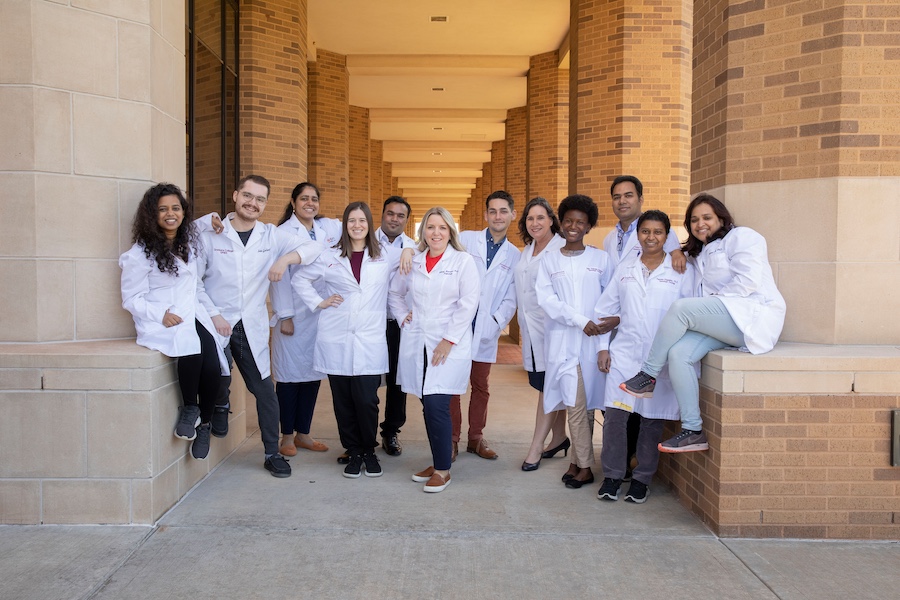“I don’t believe we can maximize our impact on ovarian cancer without embracing opportunities in other gynecologic cancers.”
Dr. David Huntsman
David Huntsman, MD, FRCPC, FCCMG, understands the field of ovarian cancer research. He is the Scientific Director and Co-Founder of OVCARE, which is now part of British Columbia’s Gynecologic Cancer Initiative. He works with the British Columbia Cancer Agency, Vancouver General Hospital, and is a Professor and the Canada Research Chair in Molecular and Genomic Pathology at the University of British Columbia. And he feels strongly there is much progress to be made in ovarian cancer research and treatment if we look beyond the ovary.
Dr. Huntsman was drawn to the field of ovarian cancer by the “horribly low” survival rates of the disease, which have not seen much improvement in recent years. “There’s been some uptick,” he said when he spoke at OCRA’s Ovarian Cancer National Conference in September 2022, “but we’re not where we need to be. We need to do better.”
In his remarks at the Conference, he reminisced back to the year 2000, when the Division Head of Gynecologic Oncology in the Department of Obstetrics and Gynecology at UBC, Dr. Dianne Miller, “called a meeting and said she was just sick of seeing women die of this cancer, and maybe if we work together, we could do something about it.” So they joined forces, sharing information about prevention, diagnosis, treatment and survivorship, and founded OVCARE, a multidisciplinary team that included researchers, pathologists, geneticists, epidemiologists, and gynecologic surgeons from multiple institutions.
They soon discovered that ovarian cancer subtypes were not recognized, and so all were treated and studied the same way. “The classification system used by pathologists, like myself, did not work,” Dr. Huntsman said, and this led to very little progress.
He and his team worked to crystallize how they classified ovarian cancer, and were able to show both in research and in practice that the subtypes of ovarian cancer are essentially different diseases. For example, Dr. Huntsman points out that clear cell ovarian cancer, from a histotype perspective (meaning, looking at the tissues that arise during the growth of a tumor) actually has a lot more in common with kidney cancer than any other ovarian cancer.
“Every way that you can define distinct diseases – etiology, precursor lesions, molecular characteristics, presentation, clinical course, biomarker profiles, response to therapy – shows that ovarian cancers are different,” said Dr. Huntsman. “Our team coalesced around the idea that if these are different diseases, we need to treat them that way clinically and in the lab. This was a shift.”
They continued further, digging into the histotypes using next generation sequencing, uncovering key mutations in multiple types of ovarian cancer. They understood that each type had its own “journey” – traveling in and through different environments within the body. With this understanding, it became absolutely clear that the fallopian tubes and uterus were essential parts of ovarian cancer research.
“We can’t just stick with the ovaries. It doesn’t tell us what we need to know. We have to be outside the ovary to understand what’s going on inside the ovary,” Dr. Huntsman said, explaining OVCARE’s change from being just an ovarian cancer focused team to a much broader initiative – The Gynecologic Cancer Initiative. They needed to study normal and abnormal fallopian tube and uterine tissue in order to understand ovarian cancer. And it’s the same community. Patients with various gynecologic cancers – cervix, uterine, ovarian, fallopian – are all meeting in the same clinics, being treated by the same doctors. There is complementary expertise that can be brought into the ovarian cancer space.
They came up with a singular goal: if they put together everything they do in terms of prevention, diagnosis, management, and survivorship, they thought they could decrease death and suffering from gynecologic cancers by 50%. “I find this absolutely motivating,” Dr. Huntsman said.
“I want to give a shout out and thank the fallopian tubes!”
They built out their team – “It was a huge joy to recruit researchers with different skill sets,” – and began looking at all gynecologic cancers. As they dug through reports, they found a paper that had come out in Holland in 2001: when scientists studied the tissues of women who had undergone prophylactic salpingectomy and oophorectomy (the removal of fallopian tubes and ovaries, respectively), they realized that very little was going on in the ovaries. But the fallopian tubes showed signs of early cancer. These precursor lesions we now know lead to high grade serous tumors. These lesions arise on the tips of the fallopian tubes and then shed into the peritoneal cavity. Understanding this phenomenon led to doctors encouraging their patients with a BRCA mutation to undergo bilateral salpingectomy as a preventative measure for ovarian cancer. Dr. Miller took it a step further.
“Dianne Miller was an incredibly imaginative individual,” said Dr. Huntsman, “and said ‘let’s look at the general population, the 80% of women who don’t have BRCA mutations.’ She posited that if we remove the fallopian tubes at the time of hysterectomy or tubal ligation, we would prevent a large portion of HGSOC, and also clear cell and endometrial carcinomas that flow through the fallopian tubes as endometriosis before they become cancers of the ovary.”
This notion of removing fallopian tubes during a hysterectomy, or in place of a tubal ligation, is known as opportunistic salpingectomy, and Dr. Huntsman and his team believed that if doctors built this into their practice, they could reduce the incidence of ovarian cancer up to 30%. They felt that this was a safe procedure and advocated within the ovarian cancer community to adopt this surgery.
Thanks to their efforts and education, the practice in British Columbia changed: In 2008, 99.7% of patients opting for tubal ligations had their tubes tied while only .3-4% chose salpingectomies, whereas by 2017, 25% of those procedures were tubal ligations and 75% were bilateral salpingectomies. Over time, studies showed that opportunistic salpingectomy for the prevention of ovarian cancer works and is safe. There were no increases in blood transfusions or hospital stays, and more recently, it was shown that there was no change in menopausal symptoms or treatments.
Retrospective studies hinted that salpingectomies reduced the cases of ovarian cancer. And in 2022, a study in JAMA Open Network compared data between women who had hysterectomies but kept their fallopian tubes, or who had their tubes tied, and those who had opportunistic salpingectomies (their fallopian tubes removed.) The difference between expected cancers and observed cancers was significant. And the medical community believes the numbers will only keep growing farther apart as these women age.
Dr. Huntsman believes this knowledge, and change in practice, is one of “the most important things to happen in the ovarian cancer space in the last 25 years.”
“Meanwhile, over to the uterus.”
When scientists discovered a classification system of ovarian cancer that worked, and accurate diagnoses could be made based on molecular analysis, the same was not true of uterine carcinoma. “The best pathologists in the world couldn’t agree [on classifying uterine cancer],” said Dr. Huntsman. “There was no solid platform to build from.” This led to an imprecise estimation of risk of recurrence and randomly selected treatment for patients. “It was overtreatment for some and under treatment for others,” he said.”It was a depressing position.”
But that began to change in 2013. A paper came out that showed endometrial cancer could be classified into four groups, each with different features, based on molecular data. With sequencing of the tumor biopsies, it could be possible to sort these cases and thus treat patients properly. Since that time, numerous studies have set out to determine the effectiveness of this classification and pave a new way forward.
How does this relate to ovarian cancer? Clear cell and endometrioid ovarian cancers come from the endometrium, or uterine tissue, and these represent 20% of ovarian cancer cases in North America. The same classification system for uterine cancer has been found to work just as well for endometrioid ovarian cancer, and this helps tailor treatment more effectively. Furthermore, patients with this type of ovarian cancer can be connected with uterine cancer clinical trials.
“Bringing these diseases together has great benefits,” Dr. Huntsman said, “not just for those with other gynecologic cancers, but also for those with ovarian cancer.”
Where do we go from here?
Dr. Huntsman reiterated that effective ovarian cancer research requires consideration of the fallopian tubes and endometrium. “Some ovarian cancers are actually endometrial cancers in the wrong place, and should be studied and treated as such.”
Going beyond research to advocacy, Dr. Huntsman noted that uterine cancer is more common than ovarian cancer, but those patients do not benefit from the same degree of advocacy. He feels that a broader gynecologic cancer educational effort may be more impactful than the piecemeal approach that is taken currently. And this joined effort could be better aligned with professional practice groups, organizations and clinics.
“We need to think outside the box,” Dr. Huntsman concluded, “to help future ovarian cancer patients, and maybe prevent people from becoming ovarian cancer patients at all.”


